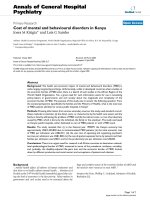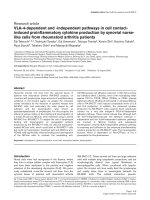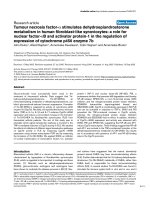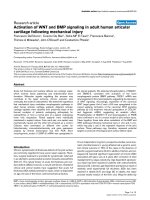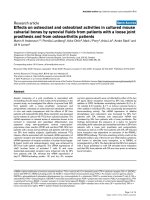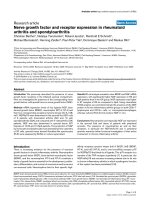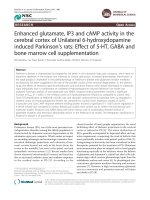Báo cáo y học: " Relative adrenal insufficiency and hemodynamic status in cardiopulmonary bypass surgery patients. A prospective cohort study" ppt
Bạn đang xem bản rút gọn của tài liệu. Xem và tải ngay bản đầy đủ của tài liệu tại đây (820.32 KB, 7 trang )
Iribarren et al. Journal of Cardiothoracic Surgery 2010, 5:26
/>Open Access
RESEARCH ARTICLE
BioMed Central
© 2010 Iribarren et al; licensee BioMed Central Ltd. This is an Open Access article distributed under the terms of the Creative Commons
Attribution License ( which permits unrestricted use, distribution, and reproduction in
any medium, provided the original work is properly cited.
Research article
Relative adrenal insufficiency and hemodynamic
status in cardiopulmonary bypass surgery patients.
A prospective cohort study
José L Iribarren*
1
, Juan J Jiménez
1
, Domingo Hernández
2
, Lisset Lorenzo
1
, Maitane Brouard
1
, Antonio Milena
3
,
María L Mora
1
and Rafael Martínez
4
Abstract
Background: The objectives of this study were to determine the risk factors for relative adrenal insufficiency in
cardiopulmonary bypass patients and the impact on postoperative vasopressor requirements.
Methods: Prospective cohort study on cardiopulmonary bypass patients who received etomidate or not during
anesthetic induction. Relative adrenal insufficiency was defined as a rise in serum cortisol ≤ 9 μg/dl after the
administration of 250 μg of consyntropin. Plasma cortisol levels were measured preoperatively, immediately before, 30,
60, and 90 minutes after the administration of cosyntropin, and at 24 hours after surgery.
Results: 120 elective cardiopulmonary bypass patients were included. Relative adrenal insufficiency (Δcortisol ≤9 μg/
dl) incidence was 77.5%. 78 patients received etomidate and 69 (88%) of them developed relative adrenal insufficiency,
(P < 0.001). Controlling for clinical characteristics with a propensity analysis, etomidate was the only independent risk
factor associated with relative adrenal insufficiency (OR 6.55, CI 95%: 2.47-17.4; P < 0.001). Relative adrenal insufficiency
patients showed more vasopressor requirements just after surgery (P = 0.04), and at 4 hours after surgery (P = 0.01). Pre
and post-test plasma cortisol levels were inversely associated with maximum norepinephrine dose (ρ = -0.22, P = 0.02;
ρ = -0.18, P = 0.05; ρ = -0.21, P = 0.02; and ρ = -0.22, P = 0.02, respectively).
Conclusions: Relative adrenal insufficiency in elective cardiopulmonary bypass patients may induce postoperative
vasopressor dependency. Use of etomidate in these patients is a modifiable risk factor for the development of relative
adrenal insufficiency that should be avoided.
Background
Hypothalamic-pituitary-adrenal axis activation is an
essential component of the general adaptation to illness
and stress and contributes to the maintenance of cellular
and organ homeostasis. Relative adrenal insufficiency
(RAI) is frequently diagnosed in critically ill patients [1-
3], and its presence is related to poorer prognosis in
patients with sepsis. This has led to recommendations for
the diagnosis and management of corticosteroid insuffi-
ciency in critically ill adult patients [4]. However, the clin-
ical impact and risk factors for RAI have not been clearly
determined in cardiopulmonary bypass (CPB) patients.
We hypothesized that the appearance of RAI could con-
tribute to more complicated postoperative management
in critically ill patients, increasing the use of vasoactive
drugs. We aimed to assess risk factors for RAI in patients
undergoing CPB, as well as their impact on postoperative
vasopressor requirements.
Methods
Study design and patients
A prospective cohort study was performed from January
to July 2007 to determine the incidence and identify risk
factors associated with the development of postoperative
RAI. We included 120 patients who underwent elective
cardiac surgery with cardiopulmonary bypass (CPB). To
avoid the confounding effect of circadian rhythm on hor-
mone levels, all operations were performed in the morn-
* Correspondence:
1
Critical Care Department. Hospital Universitario de Canarias. Ofra s/n, La
Cuesta. 38320 La Laguna. Tenerife. España
Full list of author information is available at the end of the article
Iribarren et al. Journal of Cardiothoracic Surgery 2010, 5:26
/>Page 2 of 7
ing, with general anesthesia induced between 8:30 and
9:00 am. Exclusion criteria were: history of adrenal dis-
ease, endocarditis, myocardial infarction, preoperative
fever or signs of infection, surgery without CPB, emer-
gency operations and corticoid-dependency. Postopera-
tive care took place in a 24-bed polyvalent Critical Care
Unit of University Hospital of the Canary Islands (Tener-
ife, Spain). Local institutional ethics committee approval
was given for the study protocol, and informed consent
was obtained from all patients before. This study was
conducted in accordance with the provisions of the Dec-
laration of Helsinki.
Definition of Relative Adrenal Insufficiency (RAI) and
Corticotropin test
RAI was defined as a rise in serum cortisol ≤9 μg/dl after
the administration of 250 μg of corticotropin[4]. All
patients underwent a 250 μg corticotropin test (Syn-
acthene
®
; Novartis Pharma Stein AG, Stein, Switzerland)
within the first four hours after surgery. Cortisol levels
were measured before the test, at 30, 60 and 90 minutes
after the test and finally at 24 hours after surgery. The
analysis of serum cortisol was performed by radioimmu-
noassay (Immulite
®
; DPC Diagnostic Products, Los Ange-
les, CA, USA).
Perioperative management
Anesthesia was induced and maintained by use of a stan-
darized protocol with midazolam (0.1 mg/kg/h) com-
bined with fentanyl (2-5 μg/kg/h) and cis-atracurium
(0.06-0.18 mg/kg/h). Etomidate, a short acting intrave-
nous anaesthetic used for the induction of general anaes-
thesia, was administered according to anesthetist criteria
using a dosage of 0.3 mg/kg. Systemic heparinization,
CPB, cardioplegic arrest and transfusion policy were per-
formed as previously described[5]. Fluid management
was carried out to achieve 8 to 12 mm Hg of central
venous pressure or 12 to 15 mmHg of pulmonary artery
occlusion pressure at zero positive end-expiratory pres-
sure by infusions of crystalloids and colloids. Cate-
cholamine support, when necessary, was used as follows:
Norepinephrine was titrated to achieve a mean arterial
pressure of greater or equal to 70 mmHg, and dobu-
tamine was titrated to achieve a cardiac index of greater
or equal to 2.5 L/minute per square meter. Amines were
tapered off in steps of 0.02 and 1 μg/kg per minute,
respectively.
Data collection
The data collected included demographic variables,
comorbidity (renal failure defined as serum creatinine
>1.5 mg/dl), type of surgery and postoperative course,
including relative adrenal insufficiency, norepinephrine
use, ICU stay and mortality. On admission to intensive
care, and after 4 and 24 hours during the postoperative
period, hemodynamic data were collected using a Swan-
Ganz catheter (Edwards Lifesciences LLC Irvine, CA
USA). Surgical risk was calculated using the Parsonnet
scale.
Statistical analysis
Assuming an a priori 60% presentation of the event, with
an accuracy of 10% in the estimate and using an asymp-
totic normal 95% CI, the study required the inclusion of
93 patients. In order to adjust for several confounder
variables in the regression analysis, we increased the sam-
ple size to 120. Quantitative variables are reported as
mean and standard deviation, or median and inter-
quartile range as appropriate (intensive care unit length
of stay). Nominal variables are reported as frequencies
and percentages. Assumption of normality was tested
with Kolmogorov-Smirnov test and homocedasticity with
Levene test. Comparisons between groups, (patients with
and without RAI) were performed using Pearson's chi-
squared test or Fischer's exact test for nominal variables,
and the Student's t-test or the Mann-Whitney's U test for
continuous variables, as appropriate. Propensity score
analysis was performed using backward binomial logistic
regression analysis. The dependent variable was use of
etomidate, and the independent variables were sex, age,
beta-blocker treatment, diabetes, renal failure, type of
intervention and Parsonnet score. Theses scores were
used in a second backward logistic regression analysis. In
this analysis, the dependent variable was RAI, and the
independent variables were all differences in periopera-
tive variables with a P value < 0.15, preoperative choles-
terol levels, and protein levels on arrival, together with
the propensity score. Bivariate associations were assessed
with Spearman's rank correlation coefficient. A P value of
less than 0.05 was considered statistically significant.
SPSS 15 (SPSS Inc. Chicago, IL. USA) was used.
Results
One hundred and twenty from 137 consecutive eligible
patients were included. Seventeen of them met criteria
for exclusion (8 off-pump, 2 surgical emergencies, 2 with
endocarditis, 5 corticoid-dependency), as shown in Fig-
ure 1. Demographic variables, comorbidity, medical
treatments, perioperative parameters and surgical proce-
dures of the two groups are shown in Table 1. Surgical
procedures were: 65 (54.2%) coronary by-pass grafting,
39 (32.5%) valvular replacement, 12 (10%) combined sur-
gery and 4 (3.3%) other procedures. RAI was observed in
93 (77.5%) of the whole patient sample. 78 patients
received etomidate and 69 (88%) of them developed RAI,
(P < 0.001). Logistic regression analysis including propen-
sity score showed that the use of etomidate was signifi-
cantly associated with the presence of RAI (OR 6.55, CI
Iribarren et al. Journal of Cardiothoracic Surgery 2010, 5:26
/>Page 3 of 7
95%: 2.47-17.4; P < 0.001) after adjusting for preoperative
cholesterol levels and protein levels on admission, as
shown in Table 2. The exposed attributable fraction due
to etomidate was 35% (95%CI: 15-51%).
Significantly lower cortisol levels were observed within
the 4 h postoperative period (pretest) and at 30, 60, and
90 min post-test in patients who received etomidate as
compared with those who did not (Figure 2). Mean arte-
rial pressure (MAP), systemic vascular resistance index
(SVRI), systolic volume index(SVI), mixed venous satura-
tion(SvO
2
) and lactic acid were similar in both groups,
although RAI patients required a higher dose of vasoac-
tive drugs on admission to the critical care unit and dur-
ing the postoperative period (4 h) (Figure 3). Likewise, a
tendency to longer time requiring vasoactive drugs was
also observed in RAI patients, as shown in Table 3.
We found an inverse relationship between pretest and
post-test consyntropin cortisol values at 30, 60 and 90
min. and norepinephrine dose required in the early post-
operative period (ρ = -0.20, P = 0.03; ρ = -0.23, P = 0.01; ρ
= -0.25, P < 0.01 and ρ = -0.23, P = 0.01, respectively).
Similarly, this also was observed in the postoperative
period with maximum dose of vasoactive drugs (ρ = -
0.22, P = 0.02; ρ = -0.18, P = 0.05; ρ = -0.21, P = 0.02; and
ρ = -0.22, P = 0.02, respectively). Finally, no differences
between the two groups were observed in postoperative
bleeding, re-exploration, mortality and length of stay in
the critical care unit (Table 1).
Discussion
The major finding of our study was that the use of etomi-
date was an independent risk factor for RAI in patients
undergoing CPB. This lead to higher requirements for
vasoactive drugs in the postoperative management of
these patients.
The reported prevalence of adrenal insufficiency varies
widely in critically ill patients, depending on the popula-
tion of patients studied and the diagnostic criteria.
Recently, recommendations for the diagnosis and man-
agement of corticosteroid insufficiency in critically ill
adult patients have been reported. So, RAI or critical ill-
ness-related corticosteroid insufficiency (CIRCI) is
defined as inadequate cellular corticosteroid activity for
the severity of the patient's illness [4]. In our study, the
overall incidence of RAI was 77.5%. In agreement with
previous studies describing the incidence of RAI in
patients with sepsis or undergoing cardiac surgery, our
patients on etomidate showed a higher rate of RAI (74%)
than those who did not receive etomidate [6]. The diag-
nosis of RAI was based on current recommendations as
previously reported, within 4 h after admission to the
critical care unit[7-9].
Cardiac surgery constitutes a significantly provocative
stimulus for the endogenous release of catecholamines
and stress hormones. The initiation of cardiopulmonary
bypass (CPB) procedure increases blood concentrations
of norepinephrine, epinephrine, and cortisol[10]. In this
regard, several studies have reported a rise in cortisol lev-
els at the end of surgery that persisted in the early postop-
erative period, with peak values reached 4-6 hours
postoperatively. This is followed by a partial return
toward preoperative values at 24 hours[7-9]. In contrast,
other reports have not shown variations in cortisol levels
after CPB[11,12].
This response may be impaired in many critically ill
patients,[1,2,13,14] including patients undergoing cardiac
surgery with CPB. Henzen et al. studied adrenal function
in patients who underwent CABG[15]. After administra-
tion of 1 μg of ACTH, the incidence of RAI was 25% and
there were no increasing dose requirements of vasoactive
Figure 1 Population study flow chart.
Iribarren et al. Journal of Cardiothoracic Surgery 2010, 5:26
/>Page 4 of 7
Table 1: Demographic variables and perioperative characteristics between groups.
Relative adrenal insufficiency
(n = 93)
No Relative adrenal insufficiency
(n = 27)
P
Age (years) 66 ± 12 69 ± 10 0.32
Higher than 60 years (%) 68 (73) 25 (93) 0.19
Male (%) 62(67) 22(82) 0.14
Body mass index (kg/m
2
) 28.6 ± 4.5 27.9 ± 4.6 0.54
Parsonnet
a
12.6 ± 8.6 11.7 ± 6.9 0.64
Hypertension (%) 56(60) 13(48) 0.26
Dyslipemia (%) 51(55) 11(41) 0.20
Diabetes (%) 30(32) 10(37) 0.22
Hypolipidemic drugs 63(68) 17(63) 0.64
ACE
b
inhibitors (%) 26(28) 6(22) 0.55
Cholesterol (mg/dl) 178 ± 53 162 ± 48 0.14
Etomidate (%) 69(74) 9(33) <0.001
Surgical procedure (%) 0.40
CABG
c
49(53) 16(59)
Valvular 29(31) 10(37)
Combined 11(12) 1(4)
Others 4(4) 0(0)
Aortic clamping time (min.) 51 ± 26 55 ± 29 0.52
CPB
d
time (min.) 88 ± 32 89 ± 35 0.88
Temperature (°C) 35.8 ± 0.7 35.7 ± 0.5 0.81
Protein level on ICU arrival (g/dl) 4.3 ± 0.7 4.5 ± 0.7 0.14
Postoperative bleeding (mL) 24 h 698 ± 229 694 ± 264 0.96
Re-exploration (%) 2 (2.2) 1 (3.7) 0.96
Length of stay in the ICU (days)
e
3(2-6) 2(2-4) 0.12
Mortality (%) 3(3.2) 1(3.7) 0.90
Values are expressed as means and standard deviations, and frequencies and percentages.
a
Parsonnet V et al. Circulation 1989; 79: 3-12.
b
ACE:
angiotensin converting enzyme.
c
CABG: coronary artery bypass grafting.
d
CPB: cardiopulmonary bypass.
e
Values are expressed as median and
25-75
th
percentiles.
Iribarren et al. Journal of Cardiothoracic Surgery 2010, 5:26
/>Page 5 of 7
drugs, but in that study no patients received etomidate,
which could have influenced the results.
The only risk factor associated with RAI in our study
was the use of etomidate after adjusting for confounder
variables, including a control with propensity score.
Adrenal suppression in humans with induction doses of
etomidate has been shown in several studies,[6,16-18]
suggesting suppression persisting for at least 24 h follow-
ing cardiac surgery[19]. Etomidate temporarily impairs
cortisol synthesis[6]. This drug has a very important role
in the safe induction of unstable patients, but may impair
haemodynamic status through cortisol inhibition. Nota-
bly, RAI and lower cortisol levels were related to
increased need for vasoactives drugs in the early postop-
erative period, as well as in patients with traumatic brain
injury[1]. Glucocorticoids promote the maintenance of
cardiac contractility and vascular tone and decrease the
production of nitric oxide, a major vasorelaxant and
modulator of vascular permeability[20]. Therefore, fac-
tors affecting the release and action of cortisol may mod-
ify the hemodynamic response to stress.
Because of its cortisol-inhibiting effect, the anesthetic
induction agent etomidate should be used with caution in
elderly patients undergoing elective cardiac sur-
gery[21,22]. We studied an elderly population undergoing
CPB, and more pronounced RAI was observed in patients
over 60 years compared with their younger counterparts.
It is known that adrenal response is decreased in this
population. Thus, it is plausible that the effect of etomi-
Table 2: Multivariate analysis for predicting risk factors associated with relative adrenal insufficiency.
Model 1 (Unadjusted)
ORa 95% CIb
P
Etomidate 5.75 2.28-14.5 <0.001
Model 2 (Adjusted)
Etomidate 6.55 2.47-17.4 <0.001
Cholesterol levels (mg/dl) 1.01 0.99-1.02 0.38
Protein levels on arrival (g/dl) 0.60 0.29-1.25 0.18
Propensity score 4.76 0.12-190 0.41
a
OR: odds ratio.
b
CI: confidence interval.
Figure 2 Cortisol levels in etomidate and non-etomidate pa-
tients. Baseline and stimulated plasma cortisol levels regarding the
use of etomidate. Black arrow shows cardiac surgery. 250 μg corti-
cotropin test was carried out at 4 hours after surgery. Values are means
and 95% confidence intervals. * = P < 0.001 between groups.
Figure 3 Norepinephrine requirements. Postoperative norepi-
nephrine dose per group with or without relative renal insufficiency.
Values are means and standard deviations.
Iribarren et al. Journal of Cardiothoracic Surgery 2010, 5:26
/>Page 6 of 7
date could have been magnified in these patients. Future
studies are needed to clarify this issue.
This study has certain limitations. Etomidate was used
according to anesthetist criteria, which may have intro-
duced a bias in the final results. We used a propensity
analysis in order to elucidate whether prescription of this
drug was influenced by other clinical data. Logistic
regression model confirmed that etomidate use was an
independent risk factor for RAI after adjusting for pro-
pensity score and other confounding variables.
In conclusion, both RAI and lower cortisol levels were
associated with increased need for vasoactive drugs in
elective cardiac surgery patients undergoing CPB. The
use of etomidate should be minimized in elective cardiac
surgery in order to decrease the hemodynamic disorders
in postoperative patients.
List of abbreviations
RAI: relative adrenal insufficiency; CPB: cardiopulmo-
nary bypass; ICU: intensive care unit; MAP: mean arte-
rial pressure; SVRI: systemic vascular resistance index;
CIRCI: critical illness-related corticosteroid insuffi-
ciency; CABG: coronary artery bypass grafting.
Competing interests
The authors declare that they have no competing interests.
Authors' contributions
JLI and JJ: were responsible for the study design, data collection, processing
blood samples during the study, statistical analysis, data interpretation, and
drafting the manuscript.
DH: was responsible for the statistical analysis, data interpretation, and drafting
the manuscript.
LL, MB, LL, SP, RP and MLM: were responsible for data collection and processing
blood samples during the study and provided useful suggestions.
AM: was responsible for determination of cortisol levels.
RM: was the surgeon and was responsible for preoperative clinical and analyti-
cal data collection.
All authors read and approved the final manuscript.
Acknowledgements
The authors thank the staff of the Intensive Care Unit and Biochemistry Labora-
tory (Hospital Universitario de Canarias, La Laguna, Spain) for their invaluable
collaboration in this study.
Table 3: Hemodynamic parameters and vasoactive drug requirements between groups.
No relative adrenal
insufficiency (n = 27)
Relative adrenal insufficiency
(n = 93)
P
MAP
a
(mmHg) 0 hrs 82 ± 11 87 ± 16 0.49
MAP (mmHg) 4 hrs 77 ± 13 81 ± 10 0.26
MAP (mmHg) 24 hrs 83 ± 16 80 ± 10 0.29
SVRI
b
(dyn-seconds·cm
-5
/m
2
) 0 hrs 2166 ± 843 2212 ± 750 0.47
SVRI (dyn-seconds·cm
-5
/m
2
) 4 hrs 1744 ± 392 1929 ± 402 0.61
SVRI (dyn-seconds·cm
-5
/m
2
) 24 hrs 1924 ± 782 1766 ± 772 0.39
Systolic Volume index (mL/m
2
) 4 hrs 36.1 ± 5.6 35.1 ± 4.7 0.74
Mixed venous saturation (%) 4 hrs 70 ± 10 69 ± 9 0.89
Lactic acid (mmol/L) 4 hrs 2.4 ± 0.9 2.3 ± 0.8 0.32
Norepinephrine (mcg/kg/min) 0 hrs 0.03 ± 0.03 0.08 ± 0.08 0.02
Norepinephrine (mcg/kg/min) 4 hrs 0.01 ± 0.02 0.08 ± 0.08 0.01
Norepinephrine hrs 13 ± 25 51 ± 86 0.05
Values are expressed as means and standard deviations.
a
MAP: median arterial pressure.
b
SVRI: systemic vascular resistance index.
Iribarren et al. Journal of Cardiothoracic Surgery 2010, 5:26
/>Page 7 of 7
Author Details
1
Critical Care Department. Hospital Universitario de Canarias. Ofra s/n, La
Cuesta. 38320 La Laguna. Tenerife. España,
2
Nephrology Department. Hospital
Universitario Carlos Haya. Avenida de Manuel Agustín Heredia, 34, 29001
Málaga. España,
3
Biochemistry Laboratory. Hospital Universitario de Canarias.
Ofra s/n, La Cuesta. 38320 La Laguna. Tenerife. España and
4
Cardiac Surgery
Department. Hospital Universitario de Canarias. Ofra s/n, La Cuesta. 38320 La
Laguna. Tenerife. España
References
1. Cohan P, Wang Ch, McArthur DL, Cook SW, Dusick JR, Armin B, Swerdloff
R, Vespa P, Muizelaar JP, Cryer HG, Christenson PD, Kelly DF: Acute
secondary adrenal insufficiency after traumatic brain injury: A
prospective study. Crit Care Med 2005, 33:2358-2366.
2. Weant KA, Sasaki-Adams D, Dziedzic K, Ewend M: Acute relative adrenal
insufficiency after aneurismal subarachnoid hemorrhage. Neurosurgery
2008, 63:645-650.
3. de Jong MF, Beishuizen A, Spijkstra JJ, Groeneveld ABJ: Relative adrenal
insufficiency as a predictor of disease severity, mortality, and beneficial
effects of corticosteroid treatment in septic shock. Crit Care Med 2007,
35:1896-1903.
4. Marik PE, Pastores SM, Annane D, Meduri GU, Sprung CL, Arlt W:
Recommendations for the diagnosis and management of
corticosteroid insufficiency in critically ill adult patients: Consensus
statements from an international task force by the American College of
Critical Care Medicine. Crit Care Med 2008, 36:1937-1949.
5. Jimenez JJ, Iribarren JL, Lorente L, Rodriguez JM, Hernandez D, Nassar I,
Perez R: Tranexamic acid attenuates inflammatory response in
cardiopulmonary bypass surgery through blockade of fibrinolysis: a
case control study followed by a randomized double-blind controlled
trial. Crit Care 2007, 11:R117.
6. Wagner RL, White PF, Kan PB, Rosenthal MH, Feldman D: Inhibition of
adrenal steroidogenesis by the anesthetic etomidate. N Engl J Med
1984, 310:1415-1421.
7. Velissaris T, Tang AT, Murray M, Mehta RL, Wood PJ, Hett DA, Ohri SK: A
prospective randomized study to evaluate stress response during
beating-heart and conventional coronary revascularization. Ann
Thorac Surg 2004, 78:506-512.
8. Maggio M, Ceda GP, De Cicco G, Cattadori E, Visoli S, Ablondi F, Beghi C:
Acute changes in circulating hormones in older patients with impaired
ventricular function undergoing on-pump coronary artery bypass
grafting. J Endocrinol Invest 2005, 28:711-719.
9. Hoda MR, El-Achkar H, Schmitz E, Scheffold T, Vetter HO, De Simone R:
Systemic stress hormone response in patients undergoing open heart
surgery with or without cardiopulmonary bypass. Ann Thorac Surg
2006, 82:2179-2186.
10. Reves JG, Karp RB, Buttner EE, Tosone S, Smith LR, Samuelson PN, Kreusch
GR, Oparil S: Neuronal and adrenomedullary catecholamine release in
response to cardiopulmonary bypass in man. Circulation 1982,
66:49-55.
11. Gruber EM, Laussen PC, Casta A, Zimmerman AA, Zurakowski D, Reid R,
Odegard KC: Stress response in infants undergoing cardiac surgery: a
randomized study of fentanyl bolus, fentanyl infusion, and fentanyl-
midazolam infusion. Anesth Analg 2001, 92:882-890.
12. Winterhalter M, Brandl K, Rahe-Meyer N, Osthaus A, Hecker H, Hagl C,
Adams A: Endocrine stress response and inflammatory activation
during CABG surgery. A randomized trial comparing remifentanil
infusion to intermittent fentanyl. Eur J Anaesthesiol 2008, 25:326-335.
13. Annane D, Maxime V, Ibrahim F, Alvarez JC, Abe E, Boudou P: Diagnosis of
adrenal insufficiency in severe sepsis and septic shock. Am J Respir Crit
Care Med 2006, 174:1319-1326.
14. Gotoh S, Nishimura N, Takahashi O, Shiratsuka H, Horinouchi H, Ono H,
Uchiyama N, Chohnabayashi N: Adrenal function in patients with
community-acquired pneumonia. Eur Respir J 2008, 31:1268-1273.
15. Henzen C, Kobza R, Schwaller-Protzmann B, Stulz P, Briner VA: Adrenal
function during coronary artery bypass grafting. Eur J Endocrinol 2003,
148:663-668.
16. Schenarts CL, Burton JH, Riker RR: Adrenocortical dysfunction following
etomidate induction in emergency department patients. Acad Emerg
Med 2001, 8:1-7.
17. Malerba G, Romano-Girard F, Cravoisy A, Dousset B, Nace L, Lévy B,
Bollaert PE: Risk factors of relative adrenocortical deficiency in intensive
care patients needing mechanical ventilation. Intensive Care Med 2005,
31:388-392.
18. den Brinker M, Hokken-Koelega AC, Hazelzet JA, De Jong FH, Hop WCJ,
Joosten KFM: One single dose of etomidate negatively influences
adrenocortical performance for at least 24 h in children with
meningococcal sepsis. Intensive Care Med 2008, 34:163-168.
19. Zurick AM, Sigurdsson H, Koehler LES: Magnitude and time course of
perioperative adrenal suppression with single dose etomidate in male
adult cardiac surgical patients. Anesthesiology 1986, 65:A248.
20. Marik PE, Zaloga GP: Adrenal insufficiency in the critically ill: a new look
at an old problem. Chest 2002, 122:1784-1796.
21. Cotton BA, Guillamondegui OD, Fleming SB, Carpenter RO, Patel SH,
Morris JA, Arbogast PG: Increased risk of adrenal insufficiency following
etomidate exposure in critically injured patients. Arch Surg 2008,
143:62-67.
22. Hildreth AN, Mejia VA, Maxwell RA, Smith PW, Dart BW, Barker DE: Adrenal
suppression following a single dose of etomidate for rapid sequence
induction: a prospective randomized study. J Trauma 2008, 65:573-579.
doi: 10.1186/1749-8090-5-26
Cite this article as: Iribarren et al., Relative adrenal insufficiency and hemo-
dynamic status in cardiopulmonary bypass surgery patients. A prospective
cohort study Journal of Cardiothoracic Surgery 2010, 5:26
Received: 20 October 2009 Accepted: 19 April 2010
Published: 19 April 2010
This article is available fro m: http://www. cardiothoracics urgery.org/con tent/5/1/26© 2010 Iribarren et al; licensee BioMed Central Ltd. This is an Open Access article distributed under the terms of the Creative Commons Attribution License ( ), which permits unrestricted use, distribution, and reproduction in any medium, provided the original work is properly cited.Journal of Cardiothoracic Surgery 2010, 5:26


